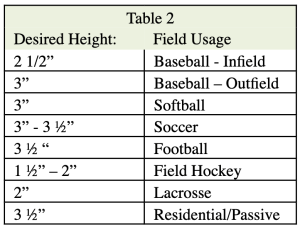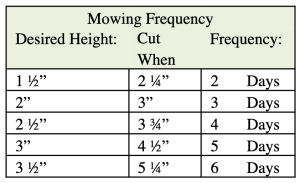 Generally, when looking at what height to mow, never remove more than one third of the grass height in a single mowing. Cutting the grass too short can weaken the turf and make it more susceptible to stress, diseases, and weeds. Furthermore, do not trust the settings on the mower deck to accurately reflect the actual height of cut (HOC). Measure the blade height on a flat surface, i.e. driveway. A simple cheat for 3.5″ HOC is to place a 2×4 on its side under the blade (obviously, make certain the mower is turned off…). Lastly, tire pressure and—if a ride-on mower is used—weight of the operator, will affect the height of cut. So….Measure!
Generally, when looking at what height to mow, never remove more than one third of the grass height in a single mowing. Cutting the grass too short can weaken the turf and make it more susceptible to stress, diseases, and weeds. Furthermore, do not trust the settings on the mower deck to accurately reflect the actual height of cut (HOC). Measure the blade height on a flat surface, i.e. driveway. A simple cheat for 3.5″ HOC is to place a 2×4 on its side under the blade (obviously, make certain the mower is turned off…). Lastly, tire pressure and—if a ride-on mower is used—weight of the operator, will affect the height of cut. So….Measure!

The requirements for turf height on athletic fields are different than residential lawns. On an athletc field, ball size for the sport being played should relate to HOC. Given a lacrosse ball is significantly smaller than a soccer ball, both do not require a field to be maintained at 2” HOC. Also, a field that we play lacrosse on March and April should not be maintained at 2” all year, when football or soccer is going to be played on it in September.
Residential lawns may be maintained at 3 – 3 ½” throughout most of the season. During extreme heat, consider maintaining a HOC of 4”. Final cut of the season should be at 2 ½”.
Mowing Frequency
The table below details frequency with which to mow, as it correlates with HOC.
 Adjust the mowing frequency according to the growth rate of the grass. During periods of active growth, you may need to mow more frequently, while during slower growth periods, you can mow less often. Maintaining a shorter HOC on an athletic field will require more frequent mowing. Typically, weekly mowing is suitable for most residential lawns, especially if a HOC of 3 – 3 ½” is being maintained.
Adjust the mowing frequency according to the growth rate of the grass. During periods of active growth, you may need to mow more frequently, while during slower growth periods, you can mow less often. Maintaining a shorter HOC on an athletic field will require more frequent mowing. Typically, weekly mowing is suitable for most residential lawns, especially if a HOC of 3 – 3 ½” is being maintained.
There’s a lot to mowing beyond what height to mow. So, our next blog covers additional guidelines for proper mowing practices. Stay tuned for more!
